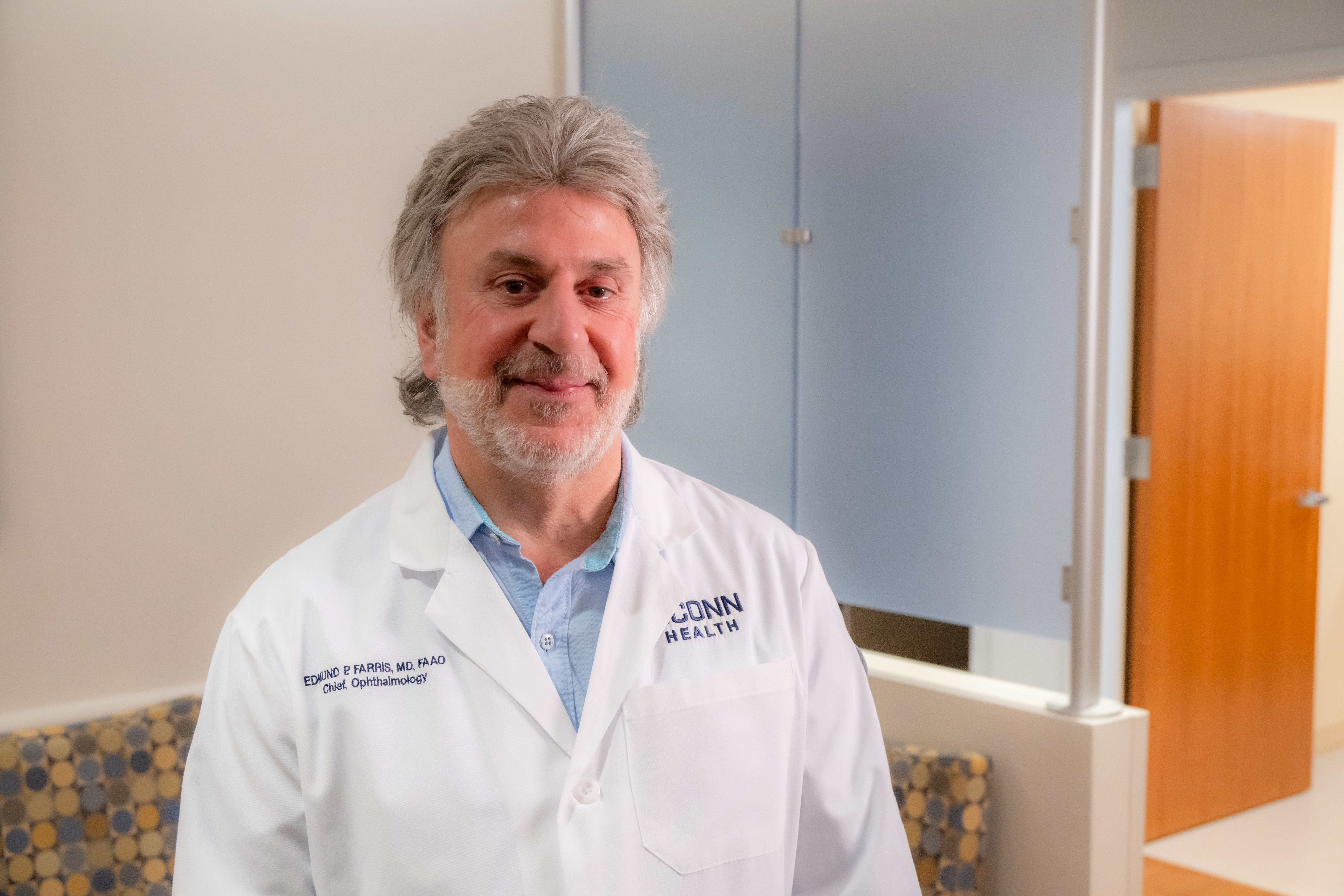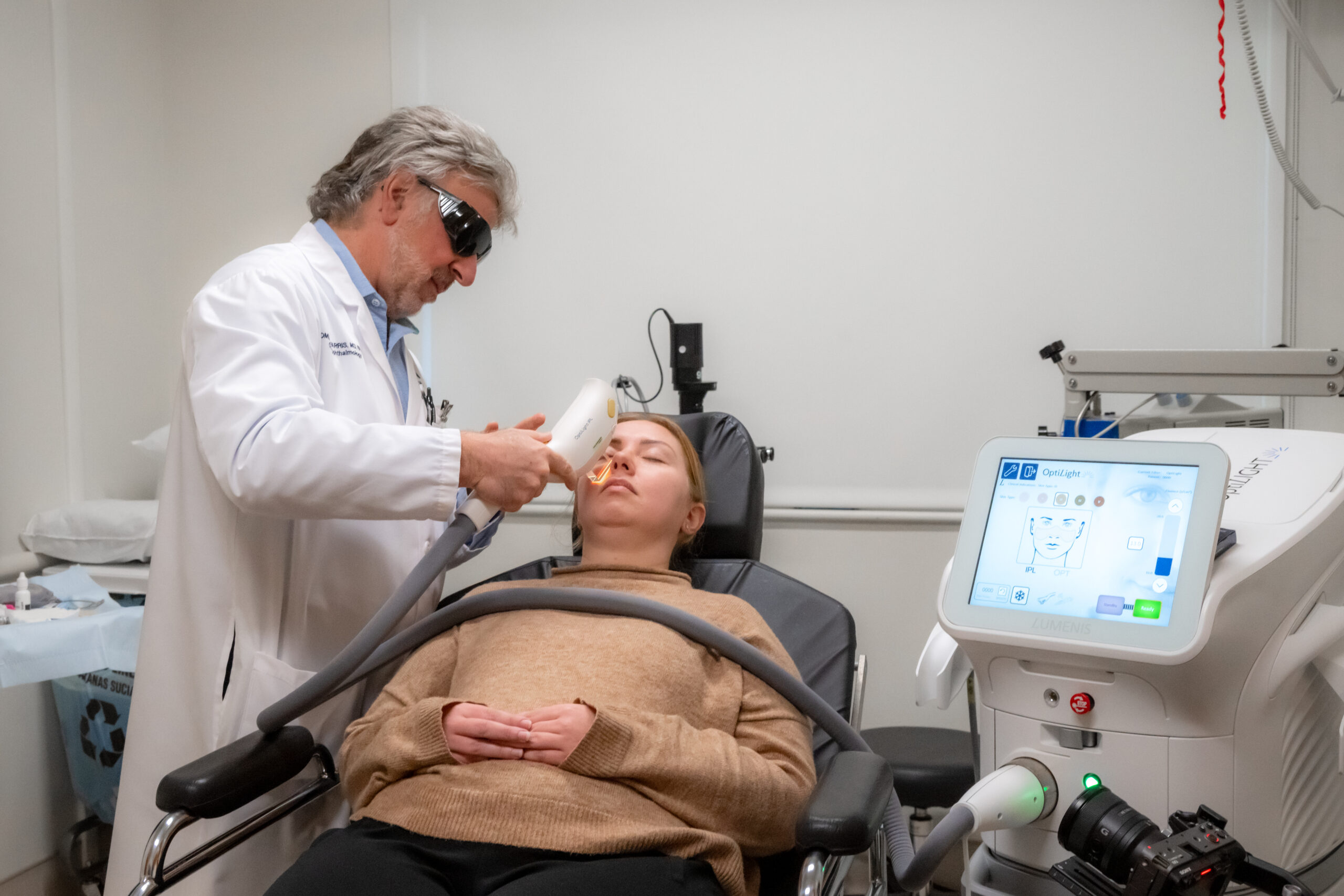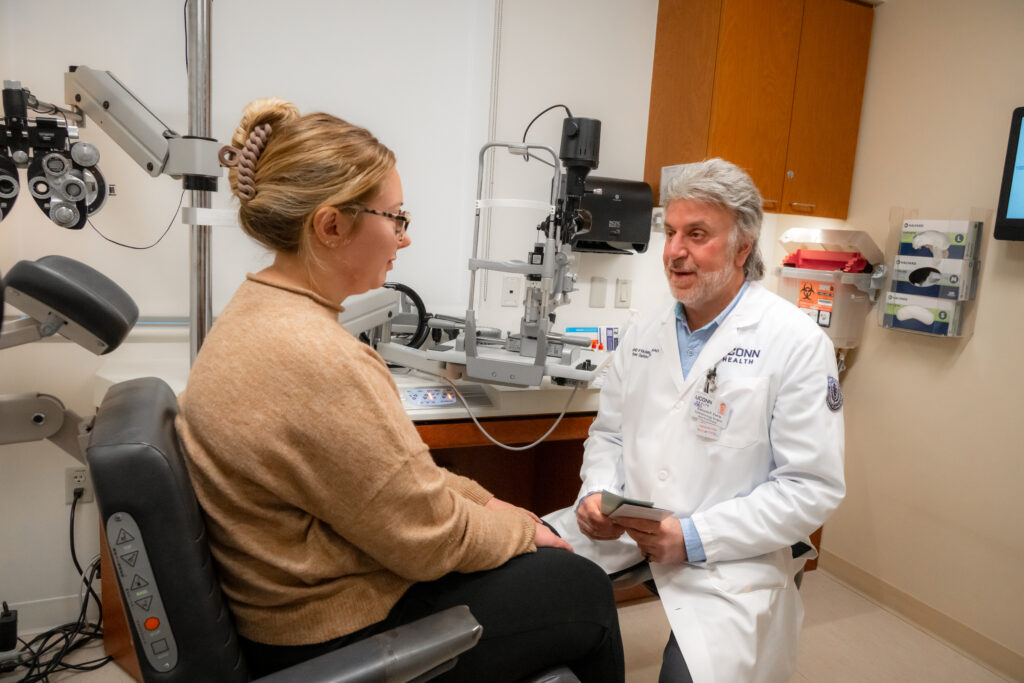UConn Health Achieves Excellence in Eye Care in Record Time: Edmund P. Farris, M.D. Chief, Division of Ophthalmology
Written by Steven Blackburn / Photography by Tina Encarnacion/UConn Health
Edmund P. Farris, M.D.’s very personal experience with dry eye drives his many accomplishments at UConn Health. Despite only joining in October 2024, those experiences have given Dr. Farris the means to help the Farmington campus achieve the recognition as a Dry Eye Center of Excellence. The center provides an impressive array of diagnostic and therapeutic modalities to treat dry eye, a condition where the eyes fail to produce enough tears or the tears evaporate too quickly, leading to dryness, discomfort and even loss of vision.
Dr. Farris began his professional career as a glaucoma-trained surgeon in the early 1990s, during which time he also taught residents, fellows and students and lectured across the country. All that abruptly ended in 2012 when he suffered significant, debilitating complications a few months after undergoing vision correcting LASIK eye surgery preventing him from performing glaucoma surgery.
This setback compelled Dr. Farris to study the very disease that affected him. By 2015, he had added dry eye specialist to his expansive resume. He now leads the Division of Ophthalmology at UConn Health, which, Dr. Farris believes, provides more modalities for dry eye than any other practices in Connecticut. “It’s what happened to me,” he says about why he pursued dry eye. “I wanted to treat people who have similar issues as me.”

Leveraging Cutting-Edge Technology That Only Five Institutions in the U.S. Provide
Since his arrival, Dr. Farris has acquired cutting-edge equipment for UConn Health’s ophthalmology division, including OptiVize, a device that no other facility in Connecticut has. In fact, there are only a handful of institutions in the U.S. that use this technology to treat dry eye.
OptiVize helps facilitate a new form of therapy known as Blepharoexfoliation. “Bleph means lids, so you’re scrubbing the lids to remove dead skin cells, excess oils and something called biofilm, which is a film laid down by bacteria into the meibomian glands,” explains Dr. Farris. “This results in gland secretions thickening, so that the oils cannot be expressed.”
OptiVize first uses a rotating, solution-applied sponge to scrub off the surface of the glands. A device that contains fluid with a mild electric current is then applied to the lids through a contact lens. The electric current, which flows into the impacted gland, vaporizes the thick secretions without causing inflammation. “This allows us to essentially hollow out this gland, so that we can then express out its thick secretions and get the gland to produce normal oils,” explains Dr. Farris.
Taking Extra Precautions to Ensure Medical Equipment Is Safe
Dr. Farris also uses an FDA-approved Lumenis Optilight device to perform intense pulse light (IPL) therapy for patients with meibomian gland dysfunction (MGD). However, the fact that the FDA approved it for dry eye treatment is very important because, unfortunately, not every machine that’s used for these procedures receives this necessary approval.
“There are a number of IPLs out there because they’re used for many cosmetic therapies,” says Dr. Farris. “Patients have come to me who have been treated with non-approved IPLs. Some arrive with actual burn marks on their face because they were overtreated with an improper parameter.”
The proper parameters can be set via FDA-approved IPLs and are based on skin types. Another UConn Health treatment that can be used in conjunction with IPLs is called radio frequency therapy, which applies radio waves and heat around the eyes.
Recently, Dr. Farris had all these procedures performed on himself. “I want to make sure that whatever I’m doing to my patients, I’ve done to myself,” he adds. “I had some improvement in my dry eye in the first week.”
Participating in a Groundbreaking Study on Dry Eye and Screen Usage
Spreading the word about dry eye is very important to Dr. Farris due to a lack of both social and medical awareness. Although some estimates say about 16.5 million people in the U.S. suffer from dry eye, Dr. Farris agrees more with the higher estimates of there being closer to 100 to 125 million, with only 10% of Americans receiving treatment.
“It’s not just a national issue but an international issue that is really just becoming recognized as something that we need to take care of,” says Dr. Farris.
These numbers are likely much higher because dry eye can be created or worsened from prolonged exposure to an activity that everyone participates in: screen time. Prior to his appointment at UConn Health, Dr. Farris performed a study where young adults aged 18 to 20 years old played video games for four hours. He found that participants experienced a range of dry eye symptoms, such as burning and stinging sensations, itchiness, and inflammation after gaming.
“When you’re reading on your phone or playing a video game, you’re concentrating so much that your blink rate goes down,” he states. “When you blink, the muscles in your eyes squeeze, which presses the oils into the tear film. When you reduce the times you blink, it reduces the time you are pushing that oil into the tear film. This leads to the stagnation of oil within the glands, which eventually causes that oil to thicken, and that ultimately becomes problematic with evaporative dry eye or MGD.”
More Than Just Minor Discomfort: Dry Eye Can Result in Vision Loss
Dry eye can be much more debilitating than just minor pains. It can result in vision loss. “A lot of people don’t worry about dry eye because they think, ‘Oh, well, vision loss has to be related to the retina or the cataract.’ But if you have inadequate tear film, it can cause significant changes in your vision because tear film is responsible for 20% of your visual acuity,” says Dr. Farris. “We’ll have patients who come in and say, ‘In the morning, I felt great and everything was fine, but the moment I went home for the day, I couldn’t see. I was having trouble driving.’”
The pain was so bad for one of Dr. Farris’ patients that her daughter had to transport her in a wheelchair, but not because she had trouble walking. “She was experiencing so much discomfort in her eyes that she could literally not open them,” he recalls.
What The Public Needs to Know About Dry Eye Medications
Another misconception about dry eye is that artificial tears or eye drops can fix the problem. Dr. Farris refers to these treatments as Band-Aids since they only provide temporary relief. “We want to be able to treat people with dry eye early, so that it doesn’t become significant down the line and become relatively debilitating for them.”
Unfortunately, the medications that doctors usually prescribe for dry eye only treat what’s called aqueous insufficiency, which is when people don’t have enough tears to lubricate the surface of their eyes adequately. These people only make up about 20% of the dry eye population. The other 80% have meibomian gland dysfunction.
“The medications that everybody’s heard about and that you see on the television, like Restasis and Xiidra, do not really treat meibomian gland dysfunction,” says Dr. Farris. “They’re anti-inflammatories, but they mostly treat aqueous deficiency. They can reduce a little bit of inflammation, but they’re not specifically targeted towards meibomian gland dysfunction.”
Similarly, there are many forms of medication that are prescribed to treat dry eye from MGD but don’t cure the disease, including Miebo and Vevye, which is a similar organic compound to Miebo. Miebo is an organic compound that hits the surface of the eye, spreads over the cornea, and basically seals over it to reduce that evaporation because you’re not producing the oils.
A more recent drop that Dr. Farris says people might have seen in the commercials is Xdemvy to treat Demodex blepharitis, a condition that occurs when a mite called the Demodex gets into the eyelash follicles and multiplies, causing inflammation. Upon application, Xdemvy significantly reduces and eradicates these mites in and around the lashes over the course of six weeks.
“It’s a really, really good drop, but it doesn’t mean that you can just stop after you take it. The condition will come back,” adds Dr. Farris. “So, you have to do some type of maintenance therapy with good lid hygiene.”

High-Quality Preventative Diagnostics
UConn Health performs diagnostics to help identify therapeutic procedures that will better treat patients, including the InflammaDry MMP-9 for inflammation and tear osmolarity, which tests the thickness of tears to see how quickly the tears break up. UConn Health also assesses how much tears patients produce, called the tear lake, and an area along the bottom of the lids called the tear height. It also performs imaging of the meibomian glands.
“It’s a cliche to say that doctors are there to help patients, but it’s really true,” concludes Dr. Farris. “We took the Hippocratic oath regardless of what our chosen field is. In the vast majority of cases, we attempt to find the solution because we will do whatever we can to help our patients.”
Steven Blackburn is a freelance writer with more than 10 years of journalism experience in various fields, including U.S. education and Connecticut community interest stories. He lives in Winsted.







More Stories
Specialty Care for Melanoma at UConn Health
Danielle E. Luciano, M.D.: Increasing Awareness and Treatment for Endometriosis
UConn Health: Providing Expert Care to Champion Athletes and the Community